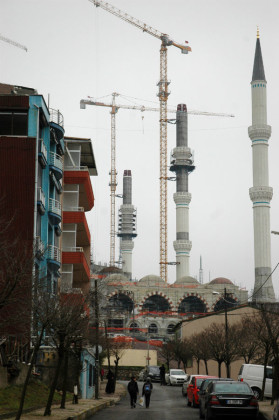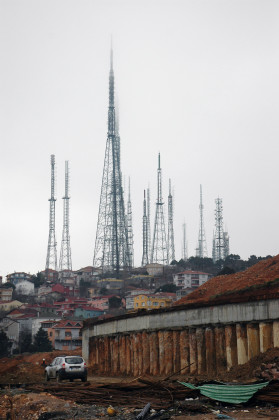Three years ago building of a new mosque began on one of the highest hills of the city, where roosters still crow and visitors and residents alike enjoy a great panoramic view of Istanbul. Situated in the Üsküdar district on the Asian side, Çamlıca Hill might only be known to some for its distant television and radio towers, which stand atop the hill. This landmark has lately been paired with the silhouette of a six-minaret complex.
Once you make it over there, you’ll find out, that the urban network seems less dense. It’s a rather calm, conservative, friendly neighborhood with plenty of green spaces, low–rise buildings with colorful facades, small front-gardens, and no traffic. The atmosphere seems nearly rural and only when looking towards the horizon are you reminded of the mega-city you are actually in. Headscarved women picking up their children from a nearby school seemed to be one of the few social activities spotted on a weekday afternoon apart from the roar of trucks circling around an estimated construction area of 57,500 m², a space equal to several football fields.
Initiated and announced by Recep Tayyip Erdoğan in 2012, the construction on this giant mosque that “will be seen from all over Istanbul” started in 2013. Since then, around 500 workers are working every day to complete it in 2016. According to the project representatives, the new Istanbul mosque (sometimes also called Çamlıca mosque) doesn’t have an officially announced name yet. It will not only provide space for more than 35,000 people but also function as a culture, education and social centre with an integrated museum, library, art gallery and conference centre. Not to forget the viewing platform and cafés that will please visitors. The project is estimated to cost between 80-200 million TL and comply with Seljuk and Ottoman styles and traditons. It will not only have six minarets like the Blue Mosque, but will also have the tallest minarets in the world. Four of the minarets will measure exactly 107.1 meters which is intended to pay tribute to the Battle of Manzikert in 1071 AD. The battle, where the Seljuk Turks defeated the Christian Byzantines, marked the beginning of the Turkish conquest of Anatolia.
Like other recent large-scale projects introduced by the ruling AK party (such as the third Bosphorus Bridge or the new Istanbul airport), the construction of the new mosque is highly controversial. Some feel that the Asian side of the city needs a mosque of this size to meet the religious needs of the Islamic community. Others criticize it as a symbol of an increasing Islamization of the Turkish society. They identify a political dimension, believing the current government is taking the opportunity to build a lasting architectural monument, in line with an ”imperial psychology.’’
At the moment, 60% of the Istanbul-Çamlıca Hill Mosque Project is said to be completed. The current status of the construction work as well as some close-up photos and simulations can be viewed (unfortunately without English translation) on the official Istanbul Cami project page and on the Üsküdar municipal website.


















